Characterization Method of Damage Information Based on Heterogeneous Network
Abstract
:1. Introduction
- The proposed network model can represent the damage process more completely and is more a in line with the actual conflict environment;
- The proposed network model is no longer attacker-centered, but defender-centered, which can analyze the structure–function characteristics of the defender in more detail, and the probability representation is no longer required.
- The established damage capacity model, damage path model, and damage node model can evaluate the damage process more objectively.
2. Network Model
2.1. Conceptions
2.2. Efficiency Attribute Sub-Network
- There is only one path for the damage load to be transmitted in , and the damage flow on the path was , where is the damage load.
- The damage capacity of damaged nodes is determined by node performance, and obeys step function distribution.
2.3. Avoidance Attribute Sub-Network
- The damage load avoidance amount is related to the target avoidance degree , and obeys the logistic function distribution, which can be described as [17]:where is the coefficient of the avoidance degree and is the midpoint of the avoidance degree.
- The damage flow on the damage path is related to the exposed area of the target structure. If the number of exposed parts of the target is , and is the exposed area of part , then the path coefficient is .In addition, the framework of is shown in Figure 4. For there is:where is damage flow of and is damage capacity of .
2.4. Structural Attribute Sub-Network
- The damage flow along the damage path is the blocking effect of the structure on the damage load, and the smaller the blocking effect, the greater the damage flow.
- Damage capacity is the extreme limit of deformation of a structure under a damage load. When the damage load transferred to the node is greater than the damage capacity of the node, the damage load overflows, and the remaining damage load continues to be transferred to the next node.
2.5. Functional Attribute Sub-Network
3. Characteristics
3.1. Damage Capacity
3.2. Correlation of Damage Path
3.3. Importance of Damaged Nodes
4. Analysis
4.1. Illustrative Example
4.2. Basic Features of HF-MCDI
4.2.1. Degree Distribution
- (1)
- The node degree of the network is mainly distributed in two parts: and . The proportion of is 65%. Among them, has the largest proportion, which is 22.5%, and the nodes of and are 20% and 15%, respectively. The results show that there are 3–5 connecting edges in most nodes of this network, which accords with the characteristics of four-sided adjacency of structural components in space. The proportion of is 35%, indicating that there are some nodes with high passing frequencies in the network, which are the key to damage flow, and they are mainly distributed in the front of and .
- (2)
- The maximum indegree of the nodes in this network is in , . The maximum outdegree of the nodes in this network is in , . has the largest ratio, which is 55%, while has 85%. This shows that the transmission of damage information in this launch platform is mainly stratified and dispersed, which is determined by the integration and modularity of the launch platform.
4.2.2. Clustering Coefficient
- (1)
- The clustering coefficient of the network is 0 at nodes 1, 2, 3, and 28 to 40. The clustering coefficients of other nodes, especially those in , all fluctuate around 0.25. The results show that there is a local aggregation phenomenon in the structure attribute subnetwork of the launching platform, and it is relatively uniform. When a node is damaged, it is easy to spread to the neighboring nodes, which is determined by the structural characteristics of the launching platform.
- (2)
- The clustering coefficient is 0 in . The result shows that the nodes in are not tightly connected because the concealment of the target and the value of the target don’t affect each other but are only logically connected, and this result is in line with reality.
- (3)
- The clustering coefficient is 0 in . Because the nodes in are connected to the nodes in , and the nodes in are not related to each other, the aggregation of function is reflected in the aggregation of structure.
4.2.3. Node Centrality
- (1)
- From the centrality of degree: The node with the highest centrality of degree of the launch platform is the total function (0.2196), followed by the mobility function (0.1502) and the launch function (0.0834). This indicates that the node of has greater influence because the centrality of degree describes the centrality of nodes in the network, indicating that the launch platform operates according to the function. Therefore, the center of the network is concentrated in .
- (2)
- From the centrality of betweenness: The centrality of betweenness is distributed in three levels. ① There are 5 nodes with a centrality value greater than 0.05, including avoidance (0.1420), value (0.0973), tube (0.0798), concealment (0.0534), and cabin (0.0506); ② There are 3 nodes with a centrality value greater than 0.02 and less than 0.05, which are the exposed nodes of ; ③ The centrality value of the remaining 80% of the nodes is less than 0.02. This suggests that the avoidance node has the greatest impact due to the fact that mesoscopic centrality describes the role of damage paths, and avoidance is a critical node in the damage path of the special equipment platform.
4.3. Damage Capacity for HF-MCDI
- (1)
- When the target is discovered, and has a high value, and does not avoid direct damage, the launch function has 1 damage path with a residual damage load factor less than 0. The maneuver function has 5 damage paths with a residual damage load factor less than 0, and 0 damage paths with a residual damage load factor less than 0 for the communication function. It can be seen that the launch platform relies only on structural protection, which has little deterrent effect on damage loads, and the percentage of safe paths is 17.14%. Among these safe paths, the safe path for the launch function is 2.86%; the safe path for the mobility function is 14.28%; and the safe path for the communication function is 0, reflecting the poor protection of the launch platform.
- (2)
- When the target is discovered and has a high value and some avoidance, that is, , the value of the residual damage load coefficient begins to decrease. When the degree of avoidance is 30%, the proportion of safe paths is 42.86%; when the degree of avoidance is 60%, the proportion of safe paths is 91.43%. When the target is not discovered or the value is low, that is, , showing that reducing the discovery probability of the target can fundamentally block the transmission of damage load.
- (3)
- There are 29 damage paths of when the target is discovered, and has a high value, and does not avoid direct damage, among which the damage path of the launch function accounts for the highest proportion (48.28%), which indicates that the launch function is the most likely to be damaged. In the damage path of , the damage path through the cabin accounts for the highest proportion, which indicates that the damage of the launch platform is mainly from the cabin.
4.4. Correlation of Damage Path for HF-MCDI
- (1)
- On the whole, the correlation distribution between the damage and the emission function is large. The damage path of Damage load–Concealment–Value–Avoidance–Tube–Launch function has the greatest correlation, , which indicates that damage load is most likely to destroy the function from this path.
- (2)
- The damage path of Damage load–Concealment–Value–Avoidance–Tube–Launch function has the greatest correlation, , which indicates that damage load is most likely to destroy the launch function from this path. The average WsRel value of launch function is 0.4901, and the correlation of the HF-MCDI of launch function is , which indicates that the correlation between launch function and damage load is highest, which is consistent with the damage capacity analysis results in Section 4.3.
- (3)
- The damage path of Damage load–Concealment–Value–Avoidance–type–Mobility function has the greatest correlation in the damage path of mobility function, , which indicates that damage load is most likely to destroy the mobility function from this path. The average WsRel value of mobility function is 0.3589, and the correlation of the HF-MCDI of mobility function is , which indicates that the correlation between mobility function and damage load is higher.
- (4)
- Damage load and communication function have few damage paths, the average WsRel value of communication function is 0.4647, and the correlation of the HF-MCDI of communication function is .
4.5. Importance of Damaged Node for HF-MCDI
- (1)
- The importance of damaged nodes is divided into three levels: ① There are 4 nodes with IMC values greater than 0.875, which are: Mobility function (1), Launch function (0.9681), Frame (0.9504), and Oil pipe (0.8965). This shows that these nodes are most important to the HF-MCDI of the launch platform. At the same time, it reflects that the launch platform takes the mobility function as the core function and the frame as the main structure; ② There are 6 nodes with IMC values greater than 0.725 and less than 0.875, in descending order of the largest to smallest, including the Missile, Compartment, Tube, Tyre, Cab, and Avoidance nodes, indicating that these nodes are of high importance to the HF-MCDI of the launch platform, that is, the exposed portion and avoidance have significant impact on transferring damage load; therefore, these nodes can be used in the optimization of protection; ③ For the remaining 30 nodes, the IMC value is less than 0.725 and greater than 0.6, and the importance of these nodes is small.
- (2)
- The importance of nodes based on IMC values, which integrate the centrality of degree to measure the structure of the HF-MCDI and the centrality of betweenness to measure the transmission of the HF-MCDI, provides a more comprehensive measure of the importance of the HF-MCDI.
5. Conclusions
- (1)
- Compared with the existing methods, the proposed method can describe the damage process more completely from the viewpoint of damage transfer, and is more consistent with the actual conflict evaluation.
- (2)
- By analyzing the basic features of the HF-MCDI, the degree distribution can indicate the structural characteristics of the damage target, the clustering coefficient can indicate the correlation characteristics of the damage information, and the node centrality can indicate the nodes with a strong influence on the damage process. The digital characterization of these fundamental features can make the study of the damage process more objective.
- (3)
- HF-MCDI establishes the damage process in the form of a network from the initiation of the damage load to the impact on the target. The correlation of damage capacity and damage path can be used to analyze the critical links of damage information, and the importance of damage nodes can be used to analyze the critical nodes of damage information. These analyses can point out the direction for the protection of the target.
Author Contributions
Funding
Institutional Review Board Statement
Informed Consent Statement
Data Availability Statement
Conflicts of Interest
References
- Lai, E.; Zhao, J.; Li, X.; Hu, K.; Chen, G. Dynamic responses and damage of storage tanks under the coupling effect of blast wave and fragment impact. J. Loss Prev. Process Ind. 2021, 73, 104617. [Google Scholar] [CrossRef]
- Tian, S.; Du, X.; Yan, Q.; Wu, J.; Zhuang, T. Damage effect of pile wharf under underwater explosion load. Mech. Adv. Mater. Struct. 2023, 30, 29–47. [Google Scholar] [CrossRef]
- Guo, Y.; Han, Z.; Guo, H.; Wang, T.; Liu, B.; Wang, D. Numerical simulation damage analysis of pipe-cement-rock combination due to the underwater explosion. Eng. Fail. Anal. 2019, 105, 584–596. [Google Scholar] [CrossRef]
- Yang, F.; Li, Z.; Zhuang, Z.; Liu, Z. Evaluating the blast mitigation performance of hard/soft composite structures through field explosion experiment and numerical analysis. Acta Mech. Sin. 2022, 38, 27–36. [Google Scholar] [CrossRef]
- Zhao, K.; Jia, F.; Shao, H. A novel conditional weighting transfer Wasserstein auto-encoder for rolling bearing fault diagnosis with multi-source domains. Knowl.-Based Syst. 2023, 262, 110203. [Google Scholar] [CrossRef]
- Zhao, K.; Hu, J.; Shao, H.; Hu, J. Federated multi-source domain adversarial adaptation framework for machinery fault diagnosis with data privacy. Reliab. Eng. Syst. Saf. 2023, 236, 109246. [Google Scholar] [CrossRef]
- Yao, T.; Miao, R.; Wang, W.; Li, Z.; Dong, J.; Gu, Y.; Yan, X. Synthetic damage effect assessment through evidential reasoning approach and neural fuzzy inference: Application in ship target. Chin. J. Aeronaut. 2022, 35, 143–157. [Google Scholar] [CrossRef]
- Jin, B.; Cruz, L.; Gonçalves, N. Deep Facial Diagnosis: Deep Transfer Learning from Face Recognition to Facial Diagnosis. IEEE Access 2020, 8, 123649–123661. [Google Scholar] [CrossRef]
- Jin, B.; Cruz, L.; Gonçalves, N. Pseudo RGB-D Face Recognition. IEEE Sens. J. 2022, 22, 21780–21794. [Google Scholar] [CrossRef]
- Zhao, K.; Jiang, H.; Wang, K.; Pei, Z. Joint distribution adaptation network with adversarial learning for rolling bearing fault diagnosis. Knowl.-Based Syst. 2021, 222, 106974. [Google Scholar] [CrossRef]
- Triana, J.; Delgado, C.A.; Martinez-Mendoza, K.L. Whale optimization algorithm guided by complex networks. Int. J. Artif. Intell. 2023, 21, 55–66. [Google Scholar]
- Nasser, A.M.; Chiang, T.S.; Ping, C.W. Distributed parallel deep learning with a hybrid backpropagation-particle swarm optimization for community detection in large complex networks. Inf. Sci. 2022, 600, 94–117. [Google Scholar] [CrossRef]
- Luo, J.; Bao, Y.; Chen, X.; Shen, C. Metapath-based deep convolutional neural network for predicting miRNA-Target association on heterogeneous network. Interdiscip. Sci. Comput. Life Sci. 2021, 13, 547–558. [Google Scholar] [CrossRef] [PubMed]
- Tan, L.; Gong, D.; Xu, J.; Li, Z.; Liu, F. Meta-path fusion based neural recommendation in heterogeneous information networks. Neurocomputing 2023, 529, 236–248. [Google Scholar] [CrossRef]
- Liu, Q.; Tan, H.S.; Zhang, Y.M.; Wang, G.Y. Dynamic heterogeneous network representation method based on meta-path. Acta Electron. Sin. 2022, 50, 1830–1839. [Google Scholar]
- Wang, L.F.; Li, H.; Zhao, G.T. Improved load re-allocation strategy based on maximum residual capacity of node. J. Northeast. Univ. (Nat. Sci.) 2020, 41, 1223–1230. [Google Scholar]
- Dong, Y.; Ma, S.; Zhang, H.; Yang, G. Wind power prediction based on multi-class autoregressive moving average model with logistic function. J. Mod. Power Syst. Clean Energy 2022, 10, 1184–1193. [Google Scholar] [CrossRef]
- Huang, X.; Liu, X.; Li, J.; Chen, Y.; Wei, D.; Ding, G. Machining deformation analysis of aircraft monolithic components based on the energy method. Int. J. Adv. Manuf. Technol. 2022, 119, 5797–5805. [Google Scholar] [CrossRef]
- Symeonidis, P.; Tiaksa, E. Transitive node similarity: Predicting and recommending links in signed social networks. World Wide Web 2014, 17, 743–776. [Google Scholar] [CrossRef] [Green Version]
- Liu, N.; Shen, J.; Yu, K.P. Weighted supply chain network node importance assessment based on improved node contraction method. J. Tianjin Univ. (Sci. Technol.) 2018, 51, 1056–1064. [Google Scholar]

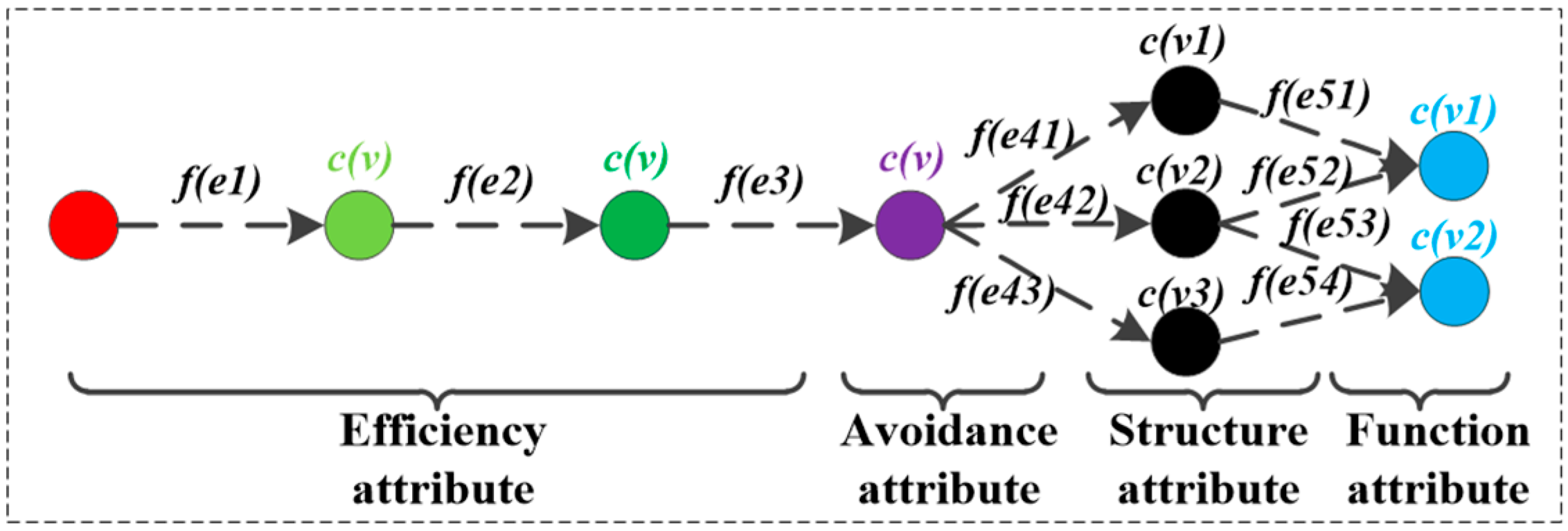

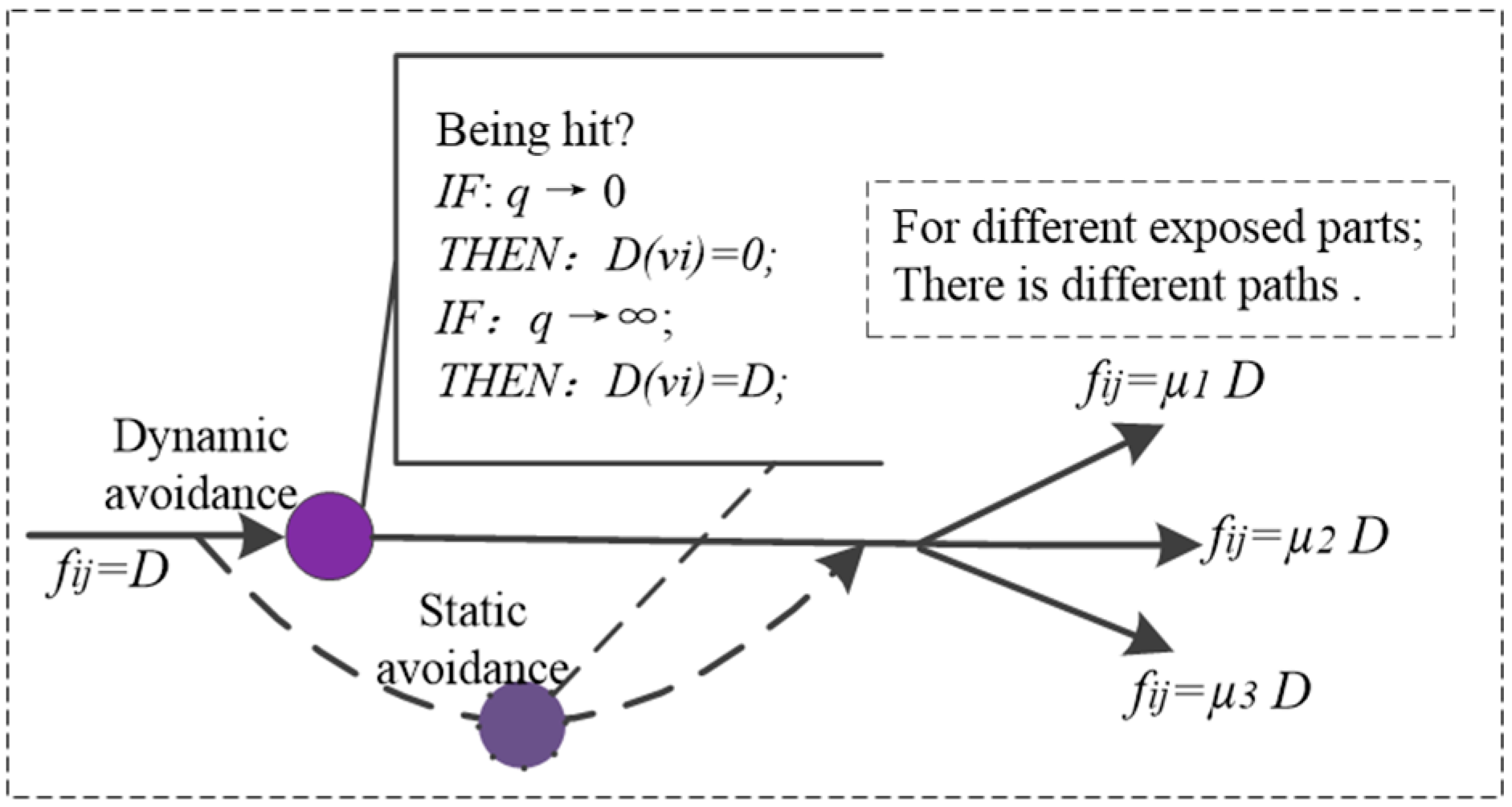
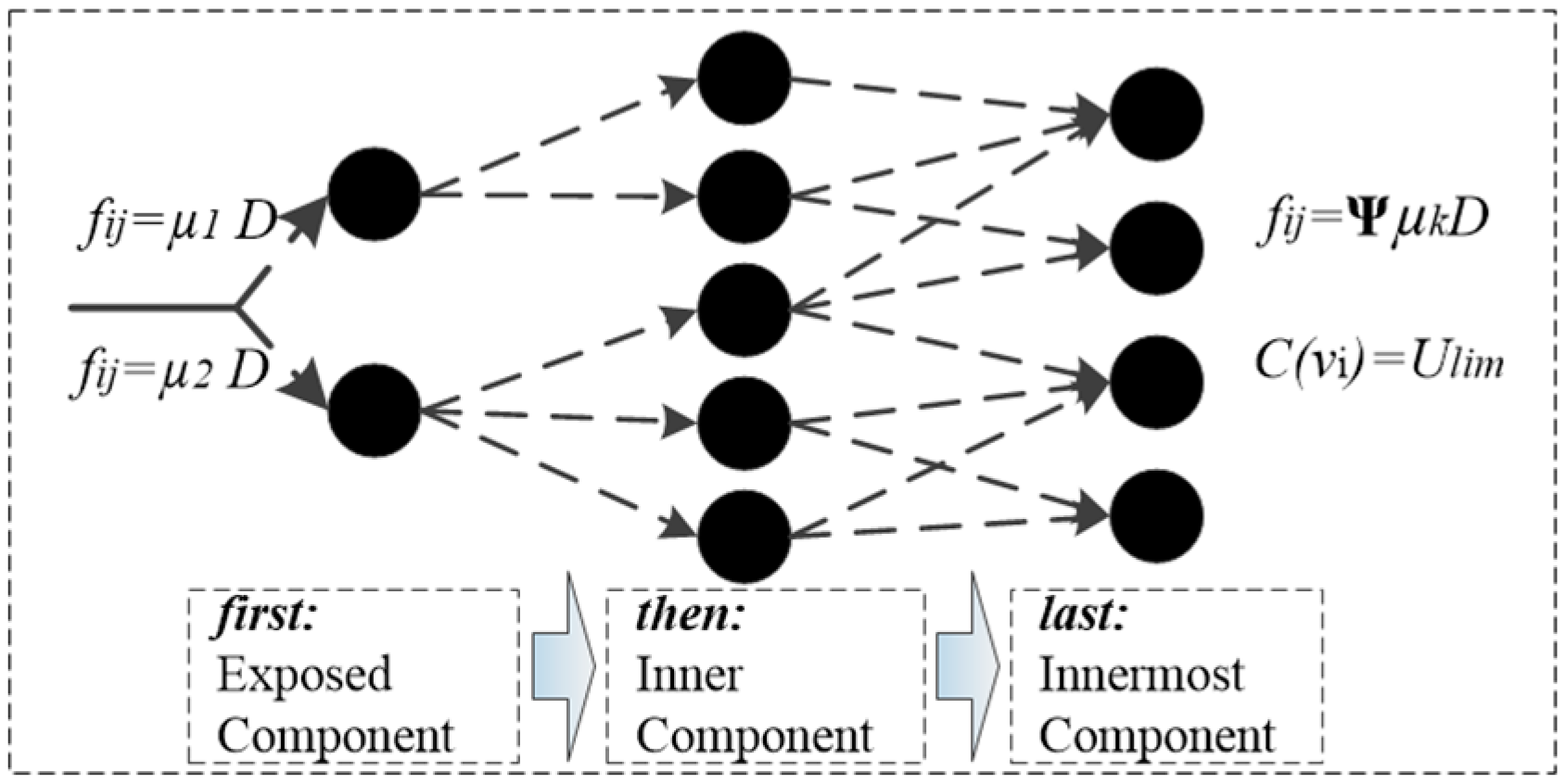
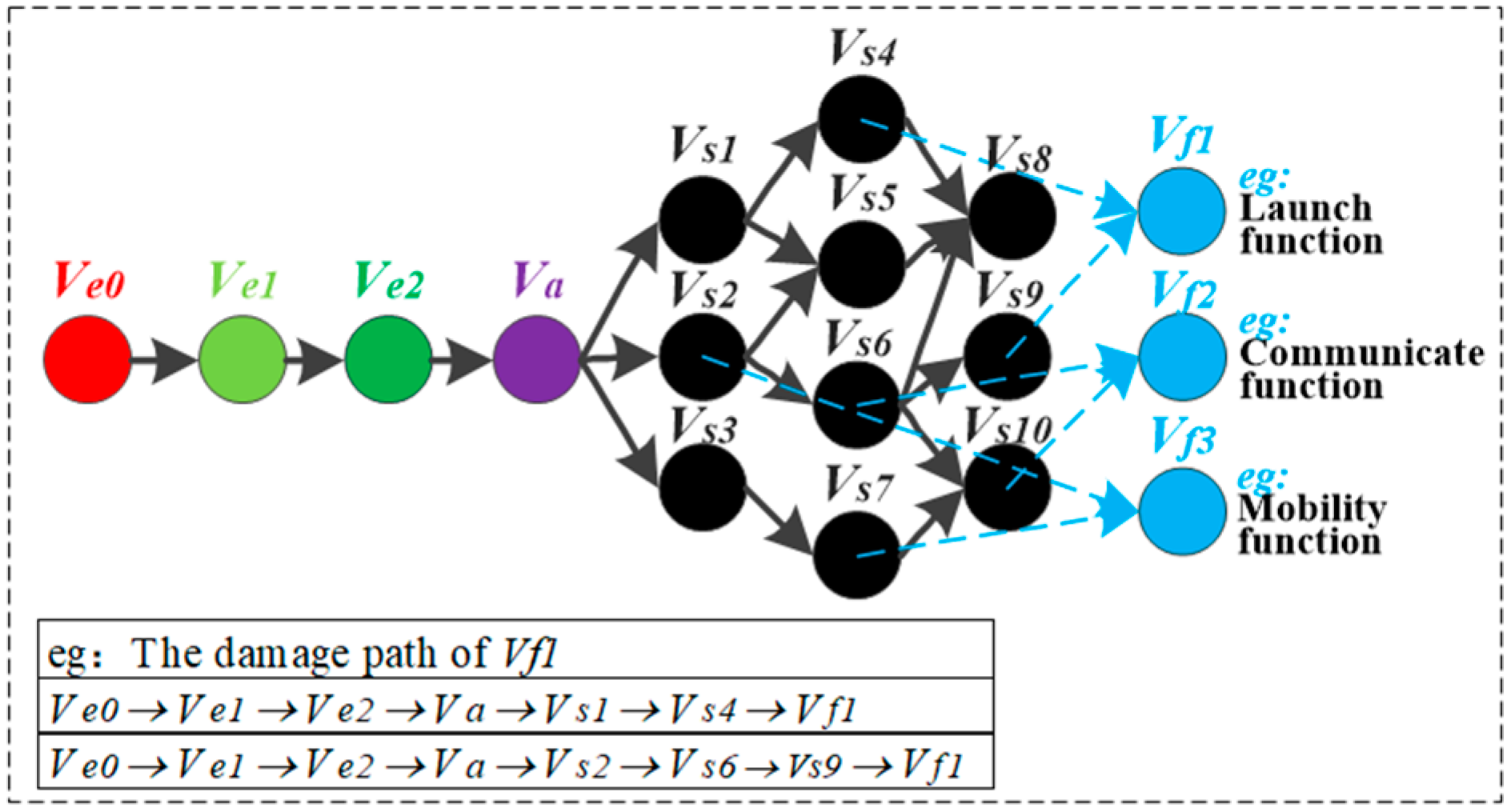
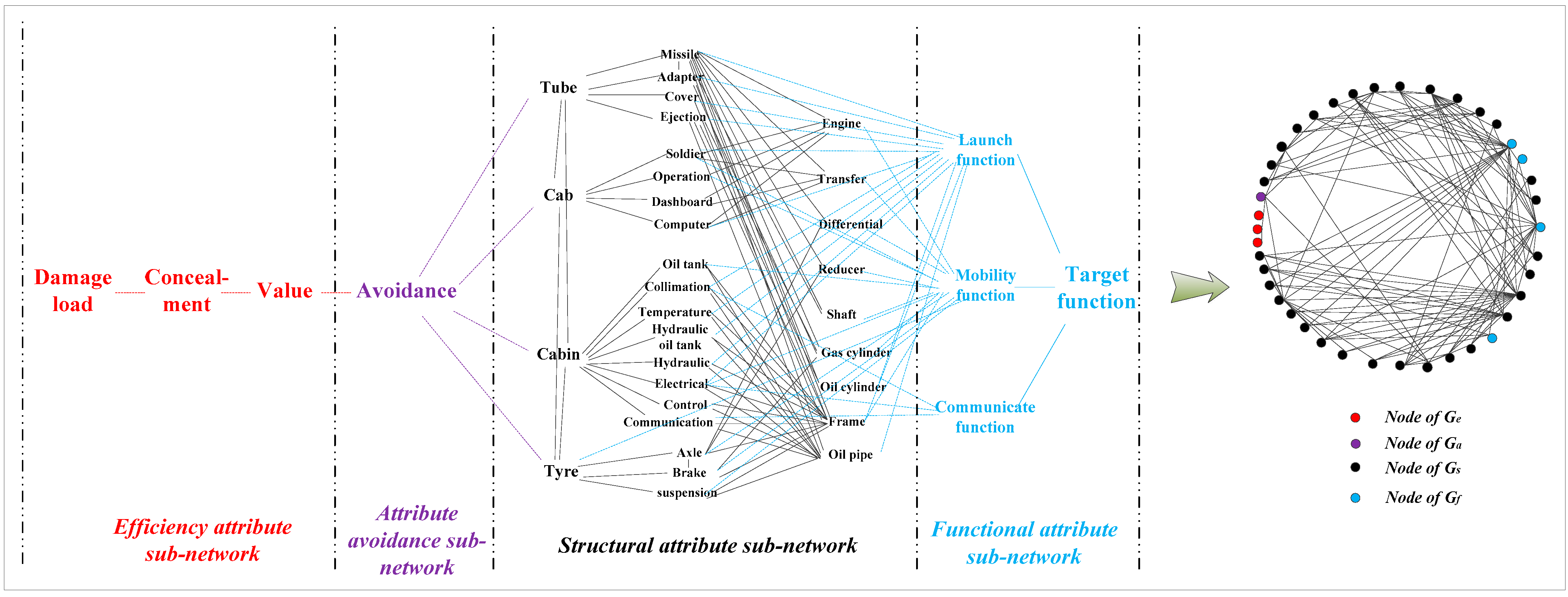
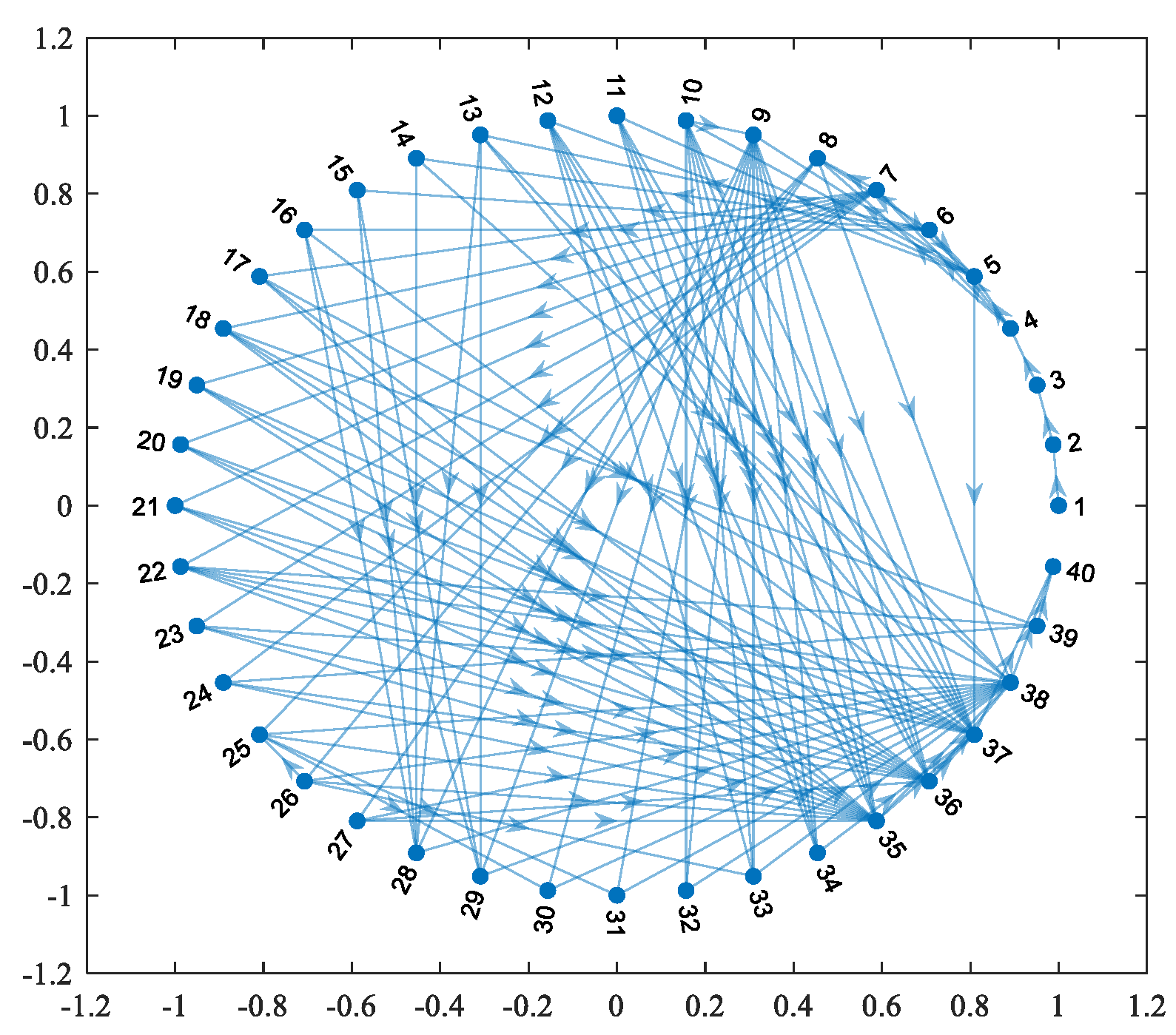




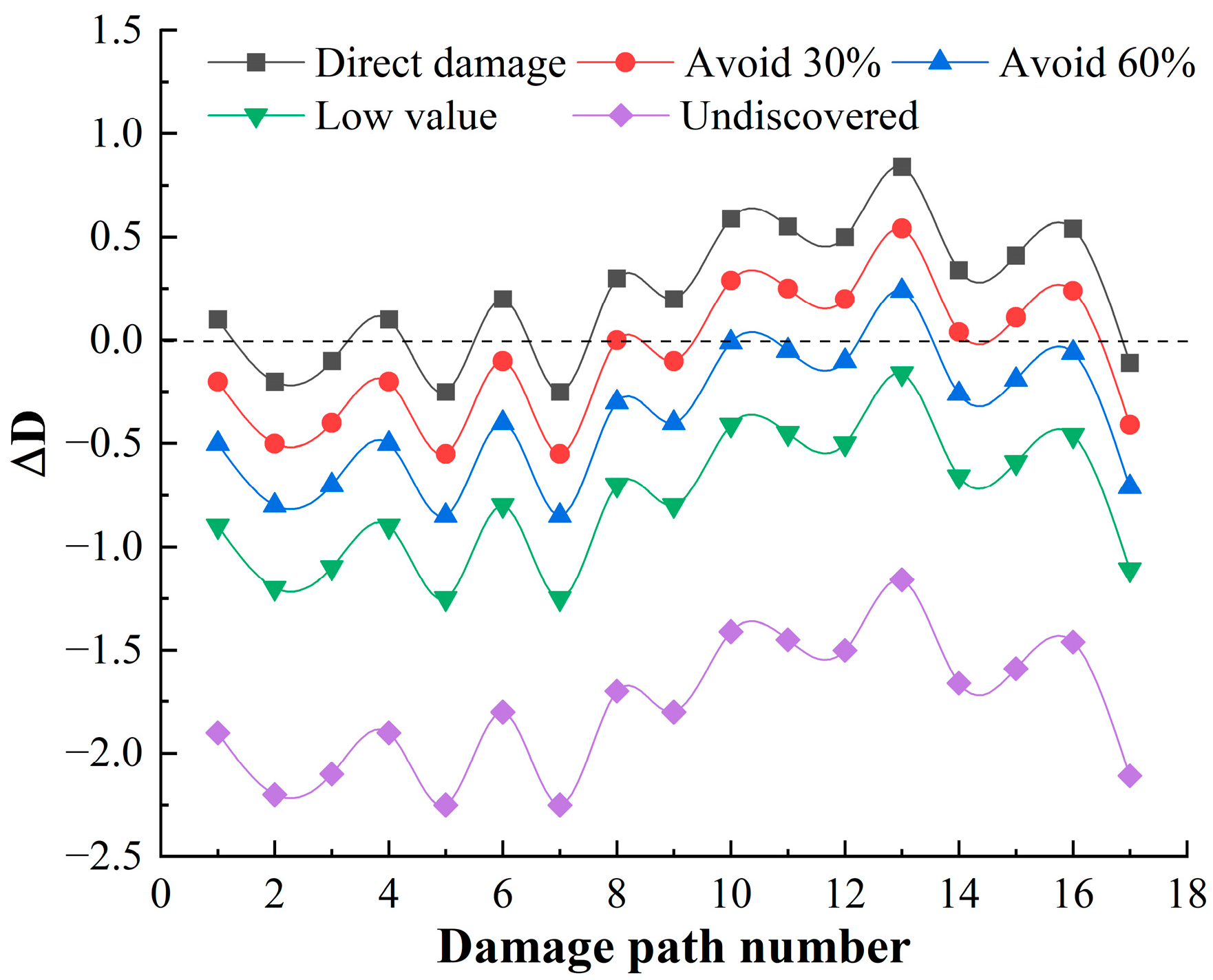
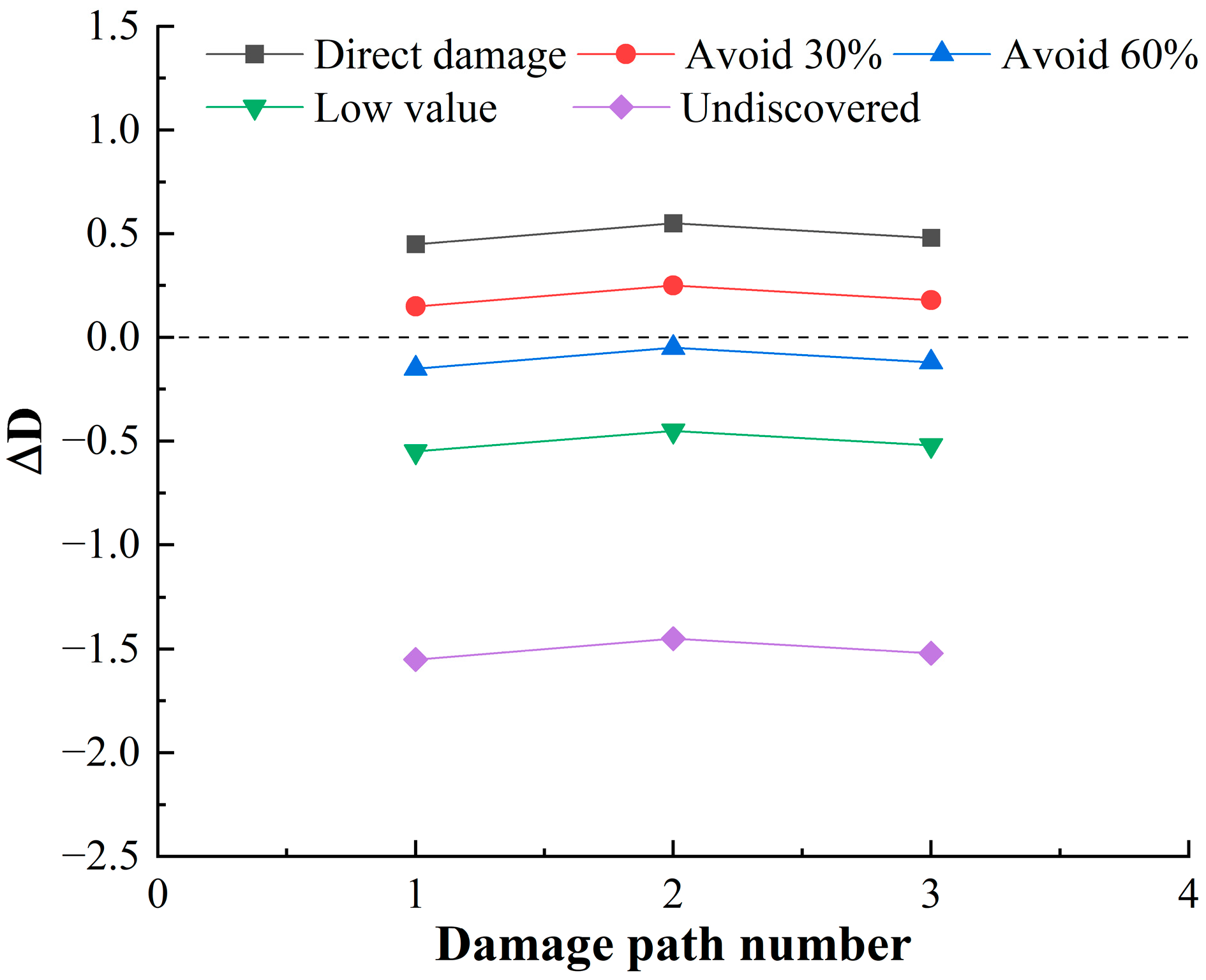
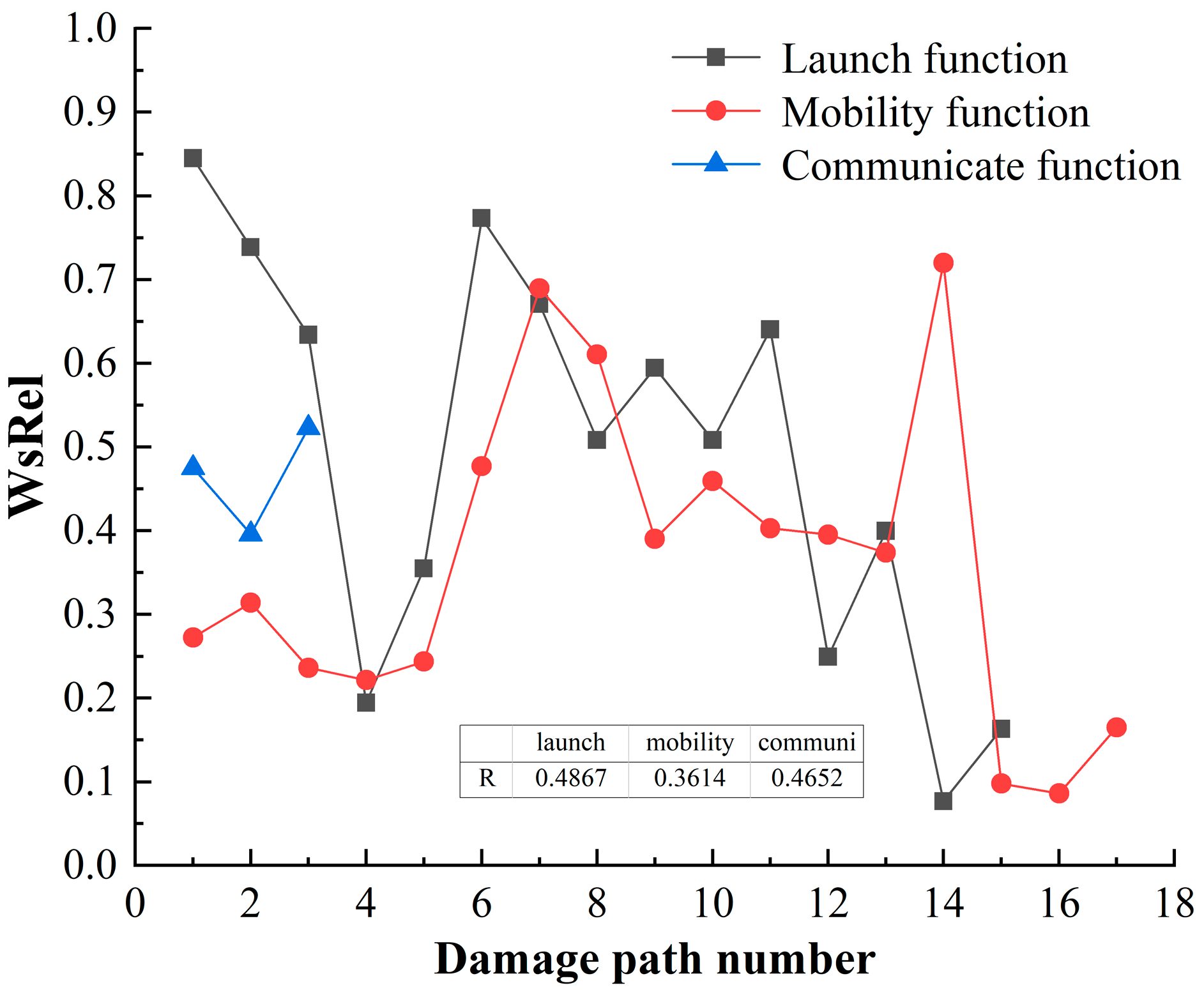

Disclaimer/Publisher’s Note: The statements, opinions and data contained in all publications are solely those of the individual author(s) and contributor(s) and not of MDPI and/or the editor(s). MDPI and/or the editor(s) disclaim responsibility for any injury to people or property resulting from any ideas, methods, instructions or products referred to in the content. |
© 2023 by the authors. Licensee MDPI, Basel, Switzerland. This article is an open access article distributed under the terms and conditions of the Creative Commons Attribution (CC BY) license (https://creativecommons.org/licenses/by/4.0/).
Share and Cite
Huang, T.; Gao, Q.; Liu, Z.; Wang, D.; Ma, D.; Gao, L. Characterization Method of Damage Information Based on Heterogeneous Network. Sensors 2023, 23, 6035. https://doi.org/10.3390/s23136035
Huang T, Gao Q, Liu Z, Wang D, Ma D, Gao L. Characterization Method of Damage Information Based on Heterogeneous Network. Sensors. 2023; 23(13):6035. https://doi.org/10.3390/s23136035
Chicago/Turabian StyleHuang, Tong, Qinhe Gao, Zhihao Liu, Dong Wang, Dong Ma, and Lei Gao. 2023. "Characterization Method of Damage Information Based on Heterogeneous Network" Sensors 23, no. 13: 6035. https://doi.org/10.3390/s23136035




